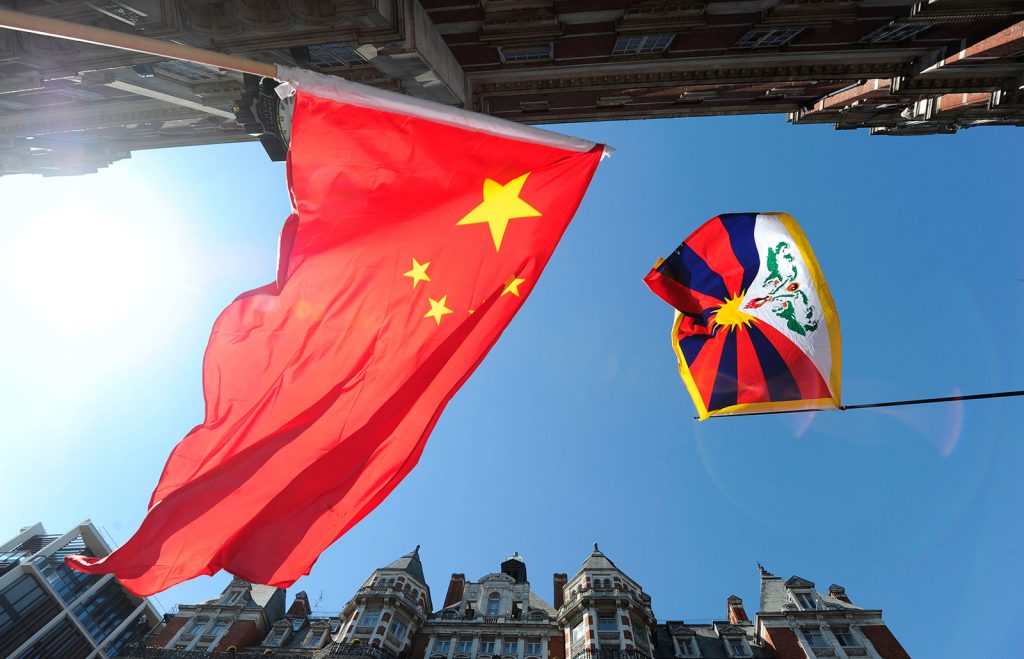Imagine at the age of twenty-three having to walk at night across the Himalayan mountains, to survive and avoid imprisonment, torture, and certain death. This is the only choice the 14th Dalai Lama, Tenzin Gyatso, could make to avoid being imprisoned and most likely killed by the Chinese military.1 This set him on a perilous journey that required him to travel by night, dressed as a soldier, for two weeks and across the tallest and most lethal mountain range, the Himalayas. 2 This was his only option because the fate of his people and their ancient culture depended on his survival.3

Tibet is nestled between the Southwestern border of China, and the Northeastern border of Nepal. Prior to China’s invasion of Tibet in 1950, Tibetan society was governed by a caste system centered around the Buddhist principle of reincarnation, the religion for a country ran as a Theocracy.4 Buddhist reincarnation suggests that if an individual lived a virtuous life, following his or her death, he or she reincarnates into the next highest caste and enjoys said caste’s privileges as the reward of a deeply humble and virtuous life. The one who served as a symbol of unity for the people and who ruled the country by maintaining Tibetan traditions in combining the duties of the spiritual leader and political leader of Tibet is the Dalai Lama.5 The Dalai Lama is not representative of any one school of Buddhist thought, instead he advocates traditional Buddhist values and the preservation of Tibetan traditions.

During the near two-hundred-year rule of China’s Qing Dynasty (1720- 1912), the Dalai Lama was the head of Tibet’s government, with the government enjoying almost complete sovereignty at times. Following the collapse of the Qing Dynasty, in 1914 a convention was held in which British India, China, and Tibet agreed to make Tibet semi-autonomous. 6 Under the agreement China, which never had full control over Tibet, handled Tibet’s foreign relations while Tibet handled its internal affairs and maintained an army. However, thirty-five years later, the plan to rob Tibetans of their autonomy and rights was set in motion.
In 1949, Mao Zedong established China as a communist state known as the People’s Republic of China. A mere two months later Mao ordered the “liberation” of Tibet from its Buddhist leaders.7 The Chinese government painted the Dalai Lama as the architect of a regressive and feudal regime, and promoted themselves as a heroic force of change. 8 Mao believed that Tibet only enjoyed autonomy due to the machinations of foreign influences. He cited Chinese traditions that claimed Tibetans were one of the five races that made up China as evidence that Tibet’s rightful place was as a province of China.9 In 1950, the Chinese military invaded Tibet and defeated its army. Instead of occupying the country, the Chinese government invited Tibetan officials to negotiate an agreement between the two. At the meeting, the Tibetan representatives signed a Seventeen-Point Agreement, acknowledging China’s sovereignty over Tibet.10 The Tibetan government refuted this agreement’s legitimacy, claiming that the delegation sent was not authorized to sign any such documents, nor were they allowed to communicate back home the nature of their situation. It was this combination of Tibet’s military defeat and forced signing of the agreement that set the stage for Mao’s occupation of Tibet and the erosion of Tibet’s freedom and rights.
In 1951, China began exerting its newly affirmed control over Tibet by sending troops into the country and implementing communist reforms. The first reform implemented was the settling Tibetans who were typically a nomadic people and the settlement of more Chinese citizens to the region. The second reform instituted was land redistribution, crops were confiscated by the Chinese government and given to a central authority with only a small amount returned to Tibetans. However, land redistribution was not implemented uniformly across Tibet, reforms were inexplicably delayed in western Tibet, and society largely continued unchanged. Eastern Tibet on the other hand rebelled in 1956, with monasteries and noblemen leading the resistance against Chinese Communists. Guerilla fighters were successful in capturing control of Southern Tibet, however this uprising was costly. The Tibetan uprising of 1959 alone costing anywhere from 85,000 to 87,000 lives, and the response by China resulted in 10,000 to 15,000 Tibetans dying over the course of three days. Fearing the capture of the Dalai Lama, Tibetan citizens surrounded his residence in an effort to protect him.11 Tibetans chose to stand against the Chinese troops outraged by the previous nine years of egregious human rights violations that included many soldiers raping and murdering Buddhist nuns and monks who resisted the reforms.
With this opportunity to escape provided to him by his people the Dalai Lama began is harrowing thirteen-day trek on foot through the Himalayas to India. Upon arriving in India, representatives sent by Prime Minister Nehru welcomed him and the refugees that had followed hoping to escape the atrocities currently being inflicted upon their homeland. The Dalai Lama worked alongside his people who fled to establish the Tibetan government in exile in Dharamshala, Himachal Pradesh, India.

During his time as both the head of the exiled government and after having stepped down from said position the Dalai Lama has worked furiously advocating not just the rights of Tibetans, but people all across the globe.12 The Dalai Lama has spoken on a variety of social issues ranging from the environment, to economics, reproductive health, sexuality, interfaith dialogue, women’s rights, and nonviolence. “Furthermore, everyone appreciates affection and at the same time has the potential for showing affection to others. With this in mind, I have found that friendship and understanding can develop.”13 All while being unable to return to his home of Tibet and not knowing how his subsequent reincarnation was to be found. His existence challenges the Chinese government’s blatant disregard for human rights, which include massacres, tortures, killings, bombardment of monasteries, extermination of nomad camps, and violating at least sixteen articles of the Universal Declaration of Human Rights. Now 81 years old, he may be the last Dalai Lama. The Dalai Lama is traditionally found following his reincarnation by the Panchen Lama, someone who is akin to our U.S. Vice President. Along with the numerous human rights violations committed the Chinese government also arrested both the Panchen Lama and his family, then named their own Panchen Lama in 1995, thereby creating uncertainty as to whether the next reincarnation would follow Tibet’s traditions or serve the Chinese government’s interests.14 To dispel this fog of doubt and concern, the Dalai Lama announced a plan to determine the future of his reincarnation, upon him turning ninety, the Dalai Lama will convene with a trust to decide if it is necessary for a 15th Dalai Lama to be recognized. If it is determined that his reincarnation is necessary, then the Gaden Phodrang Trust will search for and recognize the 15th Dalai Lama, along with the caveat that any person chosen by the Chinese government is to be dismissed by all people.15
Despite attacks on his home, his religion, and himself, the Dalai Lama persists in refusing to call for violence against China. For over fifty years this man, now in the twilight of his life, has spread his message of peace and understanding to the world hoping he could help country and his people one day see the restoration of their basic human rights following years of blatant abuse and maltreatment.16
- Charles George and Linda George, The Dalai Lama, (People in the News. Detroit: Lucent Books, 2010), 50-51. ↵
- Latson Jennifer, How and Why the Dalai Lama Left Tibet, www.time.com. ↵
- Charles George and Linda George, The Dalai Lama, (People in the News. Detroit: Lucent Books, 2010), 37. ↵
- Charles Bell, Tibet and Its Neighbors, (Vancouver: Pacific Affairs, University of British Columbia, 1937), 428-440. ↵
- Robert Thurman, Why The Dalai Lama matters, (New York: Atria Books, 2008), 3. ↵
- Jennifer Stock, Global Events: Milestone Events Throughout History: Vol 2: Asia and Oceania, (Farmington Hills: Gale, 2014), 373-376. ↵
- Charles Henry Alexandrowicz-Alexander, The American Journal of International Law: Vol. 48: No. 2, (Cambridge: Cambridge University Press, 1954), 265-274. ↵
- Charles George and Linda George, The Dalai Lama, (People in the News. Detroit: Lucent Books, 2010), 9. ↵
- Elliot Sperling, Tibet and China: The Interpretation of History Since 1950: China Perspective Vol 3, (2009), 25-26. ↵
- Alex McKay, The History of Tibet: Vol 3 The Modern Period: 1859- 1959, (London and New York: Routledge Curzon, 2003), 607-609. ↵
- Charles George and Linda George, The Dalai Lama, (People in the News. Detroit: Lucent Books, 2010), 47-48. ↵
- His Holiness The Dalai Lama and Howard C. Cutler, The Art of Happiness,(New York: Riverhead Books, 1998), 2. ↵
- Charles George and Linda George, The Dalai Lama, (People in the News. Detroit: Lucent Books, 2010), 64. ↵
- Eric A. McGuckin, Tibet: Struggle for Independence.” In History Behind the Headlines: The Origins of Conflicts Worldwide, (Farmington Hills: Gale, 2003), 272. ↵
- The Dalai Lama, Reincarnation, (Dharamsala: The Dalai Lama, 2011). ↵
- Gary L. Anderson and Kathryn G. Herr, Encyclopedia of Activism and Social Justice, Vol. 3, (Thousand Oaks: Sage Publications Inc, 2007), 417-418. ↵



51 comments
Madeline Chandler
I very much enjoyed reading your article regarding Tipet, China, and the Dalai Lama. I have obviously previously heard of the unrest China sparked in surrounding regions yet I never knew the extent of the tension with Tipet. This country experienced such transition, from treaties with China, the Dalai Lama being threatend (which ruled their country), and China planning to “free” them or force them out of the system they have had for centuries. This region experienced so much in such a short period of time and great tension for eras. Great job, I thoroughly enjoyed it!!
Andres Garcia
really great article! I enjoyed the flow of the article from the necessary background information, to the main events, and ending in what the future may hold for not only the Dalai Lama but a whole culture. I would recommend that you add a bit about how the Tibetan government in exile has developed since the Dalai Lama made the courageous expedition. Aspects such as the economic and political development of the exiled group would strengthen this article.
Caroline Bush
Great article! This article was very informative on a topic not many people know much about. The China-Tibet conflict is one that I know a bit about but not as much as what was in this article. The Dalai Lama’s journey through the Himalayan mountains is a truly incredible story about a man trying to survive to save his people. This article was very well put together and told a truly incredible story that I enjoyed reading about.
Rhys Kennedy
I know that China has quite a few regional conflicts going on with their man-made islands and with the Kashmir conflict, but this is one that I didn’t know about, but now I do, thanks to the amount of info in the article. I knew that there was some sort of conflict that had happened with the current Dalai Lama and China in the way that he was forced to leave but I had no idea that this was a larger issue.
Raul Colunga
I was aware of the Tibet-China conflict, but what I learned about reading this article was the bravery of the Dalai Lama. I was unaware of the treacherous route he had to take just to stay alive against the Chinese forces. Hopefully he passes on the title and there will be a 15th Dalai Lama that stands against the cruelty of China.
Jose Maria Llano Aranalde
I have never heard of the China Tibet conflict before. Really interesting to learn about the conflict. I didn’t know that China didn’t acknowledge Tibet as an independent nation. Its astonishing that the Dalai Lama was able to make this trek over the Himalayas. All the things that he had to go through on this journey just to be able to exit the country. It shows his will and determination that he had. Interesting article and refreshing to read about something new.
Vanessa Sanchez
This article is good because it talks about the very scary Journey against the evil communist country of china. It has taught me a lot about the conflict between China and the Peaceful Buddhist nation of Tibet, they are polar opposites, China treats very cruel and dont let people live in peace, in Tibet it is all about peace.
Mariah Garcia
The conflict that persists between China and Tibet has been something that I was always tacitly aware of but not something that consumed a lot of my thoughts throughout an average day. That being said, it is interesting and to be quite honest, a bit appalling that a whole country is trying to a people their identity, forcing them to assimilate by ignoring their land and culture. This definitely sparked an interest in the issue and I look forward to learning more about it.
Joshua Garza
This is an awesome article to read and it really tells an epic story of one man’s tough journey through the cruel Himalayan mountains to escape china and save his life even though he was taking just as much of a risk trying to pass through the Himalayan mountains. This article tells a great story of a man fighting for his life and it is very well written.
Antonio Coffee
I am in awe at the Dali Lama and his dedication to everything that is going on and making sure that Tibet is well represented. Tibet has gone through a lot of difficulties on the world stage. They have been constantly having the status and autonomy changed. It is weird to think that such a conflict has been going on for decades now.